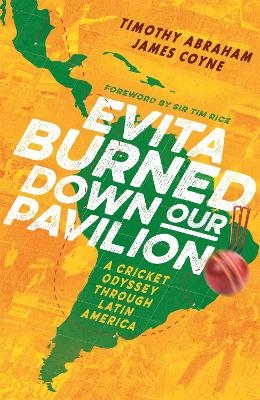
Evita Burned Down Our Pavilion
Constable (Verlag)
978-1-4721-3253-6 (ISBN)
South American food, music and culture are cutting a swathe across the western world.
But what if cricket - the quintessential English sport - were to conquer Latin America? The notion of Brazilians and Mexicans playing T20 at the Maracana or the Azteca is not as far-fetched as it sounds.
Cricket was the first sport played in almost every country of the Americas - earlier than football, rugby or baseball. In 1877, when England and Australia played the inaugural Test match at the MCG, Uruguay and Argentina were already 10 years into their derby played across the River Plate.
The visionary cricket historian Rowland Bowen reckoned that during the highpoint of cricket in South America between the two world wars, the continent could have provided the next Test nation. In Buenos Aires, where British engineers, merchants and meat-packers flocked to make their fortune, the standard of cricket was high: towering figures like Lord Hawke and Plum Warner took star-studded teams of Test cricketers to South America, and were beaten by Argentina. A combined Argentine, Brazilian and Chilean team took on the first-class counties in England in 1932.
But this is as much a social history of grit, industry and nation-building in the New World. West Indian fruit workers battled yellow fever and brutal management to carve out cricket fields next to the railway lines in Costa Rica and by the hulking locks of the Panama Canal. The legendary BBC commentator Brian Johnston, working for the family coffee business in Santos, was Brazil's best wicketkeeper until he was bed-ridden by beri-beri. Cricket was the favoured pursuit of the blustering Nitrate King of Chile; Emperors in Brazil and Mexico used the game to curry favour with Europe; General Pinochet's grandchildren avidly play the game in Chile to this day.
But the fate of cricket in South America is symbolised by Eva Perón ordering the burning down of the Buenos Aires Cricket Club pavilion when the club refused to hand over their premises to her welfare scheme. Mexican bandits, Colombian guerrillas and Argentine anarchists have kidnapped their country's leading cricketers for ransom. One of the first Uruguayan cricketers - who scored the first goal for the national football team - was killed when a whirlwind carried away the cabin he was sheltering in. This is a book short on match reports, and long on blood and guts.
Timothy Abraham reports on football in Merseyside and Manchester. He has written for every national newspaper including The Times, Daily Mail and Daily Telegraph and the BBC Sport website. He has also written on cricket for The Cricketer and the Press Association. He plays league cricket for Carmel & District CC in North Wales, and has organised nine tours to emerging cricket nations in Central and Eastern Europe. He has co-edited Wisden's Cricket Round the World section since 2012. James Coyne is the assistant editor of The Cricketer magazine. He spent five years as the assistant editor of Wisden Cricketers' Almanack before this project. He has also written for The Nightwatchman and ESPN Cricinfo, and spent three years at the Press Association, where he co-edited the ECB website. He co-wrote The Cricketer Anthology of the Ashes (Allen & Unwin). He plays league cricket for Flitwick CC in Bedfordshire, and has gone on several tours to Europe with Carmel & District CC. He has co-edited Wisden's Cricket Round the World section since 2012.
| Erscheinungsdatum | 22.05.2021 |
|---|---|
| Zusatzinfo | 16pp plate section |
| Verlagsort | London |
| Sprache | englisch |
| Maße | 152 x 232 mm |
| Gewicht | 620 g |
| Themenwelt | Sachbuch/Ratgeber ► Sport ► Ballsport |
| Weitere Fachgebiete ► Sportwissenschaft | |
| ISBN-10 | 1-4721-3253-X / 147213253X |
| ISBN-13 | 978-1-4721-3253-6 / 9781472132536 |
| Zustand | Neuware |
| Haben Sie eine Frage zum Produkt? |
aus dem Bereich


